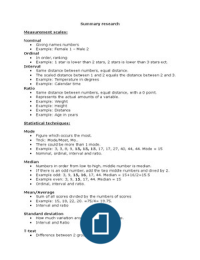Summary research
Measurement scales:
Nominal
Giving names numbers
Example: Female 1 – Male 2
Ordinal
In order, ranking
Example: 1 star is lower than 2 stars, 2 stars is lower than 3 stars ect.
Interval
Same distance between numbers, equal distance.
The scaled distance between 1 and 2 equals the distance between 2 and 3.
Example: Temperature in degrees
Example: Calendar time
Ratio
Same distance between numbers, equal distance, with a 0 point.
Represents the actual amounts of a variable.
Example: Weight
Example: Height
Example: Distance
Example: Age in years
Statistical techniques:
Mode
Figure which occurs the most.
Trick: Mode/Most, Mo..
There could be more than 1 mode.
Example: 3, 3, 8, 9, 15, 15, 15, 17, 17, 27, 40, 44, 44. Mode = 15
Nominal, ordinal, interval and ratio.
Median
Numbers in order from low to high, middle number is median.
If there is an odd number, add the two middle numbers and dived by 2.
Example odd: 3, 9, 15, 16, 17, 44. Median = 15+16/2=15.5
Example even: 3, 9, 15, 17, 44. Median = 15
Ordinal, interval and ratio.
Mean/Average
Sum of all scores divided by the numbers of scores
Example: 15, 18, 22, 20. =75/4= 18.75.
Interval and ratio
Standard deviation
How much variation around the mean/average.
Interval and Ratio
T-test
Difference between 2 groups
, Interval and ratio
Chi-square
Relationship
Normal and ordinal
Correlation
Relationship between 2 scores
Interval and ratio
Regression
Prediction
Interval and ratio
The normal distribution
These 2 numbers describe/summarize a group of data:
o Mean
o Standard Deviation
Probability: Chance that a certain event occurs.
Probability distribution: list of all possible events, with their probabilities.
Probability distribution
Event (# heads) Probability
0 ¼ (0.25)
1 ½ (0.50)
2 ¼ (0.25)
Normal distribution:
Middle line: Mean/average





